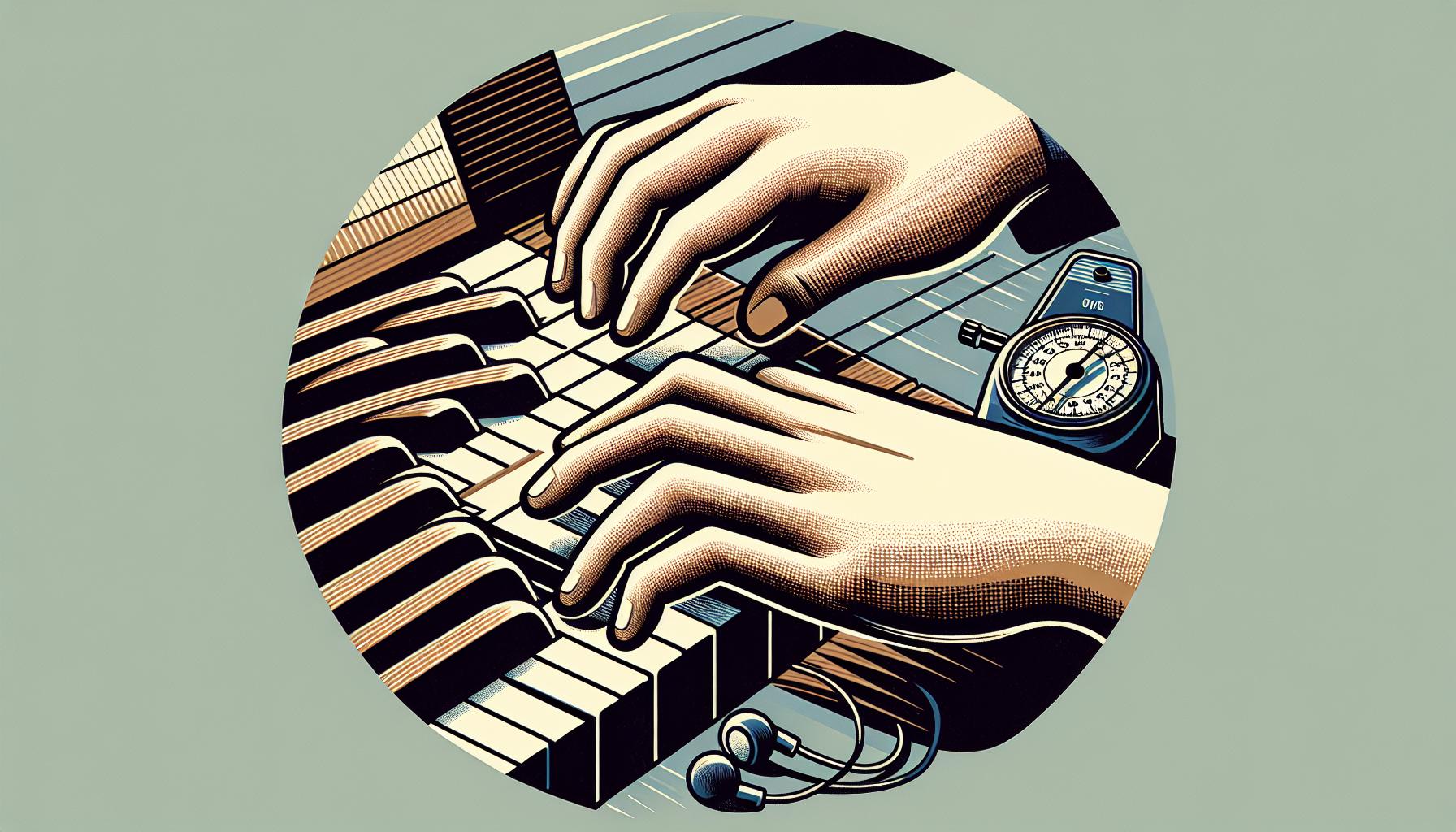Diving into the world of keyboard improvisation can feel like stepping into a vast, uncharted musical territory, especially for beginners. It's where creativity flows freely, and the rules of music bend to the will of imagination. But don't let the openness intimidate you; everyone starts somewhere, and the journey to improvisational freedom is packed with rewarding milestones.
For those just tickling the ivories with dreams of jazzing up their tunes, knowing where to begin is the first step. Improvisation might seem like a skill reserved for the musically gifted, but it's actually an art form that anyone can learn with practice, patience, and a bit of guidance. Let's ease into the basics of keyboard improvisation, setting the stage for a musical adventure that's as fulfilling as it is fun.
Understanding Keyboard Scales
Scales serve as the foundation for most musical improvisation, acting as the musical alphabet from which melodies, harmonies, and solos are formed. They're not just a series of notes but a scaffold for creativity on the keyboard. For beginners, getting to grips with scales can unlock the door to more intuitive and free-flowing improvisation.
At its core, a scale is a sequence of notes ordered by pitch. Two of the most fundamental types that beginners should focus on are the Major and Minor scales. Each has a distinct sound and emotional tone, with major scales often sounding happy or bright, while minor scales tend to convey a sadder or more reflective mood.
To start, one might look into the C Major scale, arguably the first scale most learners encounter due to its simplicity—all white keys from C to C. This simplicity makes it an excellent starting point for understanding how scales are built and for beginning to improvise. Once comfortable with the C Major scale, branching out into G Major or F Major, which introduce sharps and flats, respectively, can add variety and challenge.
Here's a quick overview of the notes in these foundational scales:
| Scale | Notes |
|---|---|
| C Major | C, D, E, F, G, A, B, C |
| G Major | G, A, B, C, D, E, F#, G |
| F Major | F, G, A, Bb, C, D, E, F |
Practicing these scales involves more than simply running one's fingers up and down the keyboard. To truly grasp them, one should:
- Practice with both hands, separately at first, then together.
- Increase speed gradually, ensuring accuracy and comfort at each step.
- Experiment with different rhythms and articulations to make scale practice more musical and engaging.
Scales are the building blocks of improvisation. They provide a structure for melody and harmony but don't dictate how they must be used. Knowing scales well gives improvisers the tools to express themselves more freely and respond in the moment to the music they're creating or interacting with.
To broaden one's improvisational vocabulary, exploring scales in different keys is essential. Shifting a scale up or down a semitone, for example, can dramatically alter its character and the improvisational ideas it sparks.
Building Chords and Progressions

Once a beginner has a grasp on keyboard scales, the next step in their improvisational journey is understanding chords and progressions. Chords form the backbone of most music genres, providing depth and harmony that scales alone can't achieve. For someone new to the keyboard, the idea of building chords might seem daunting, but it's essentially about combining notes in a way that sounds pleasing.
At its simplest, a chord is made up of three or more notes played together. The most fundamental chord for beginners is the triad, which includes the root note, a third, and a fifth. For instance, in the key of C Major, the C Major chord comprises C (the root), E (the third), and G (the fifth). This combination of notes creates a harmonious sound characteristic of the Major chord's bright and happy feel.
Progressions, on the other hand, are sequences of chords played in a certain order. They form the structural foundation of a song, leading the listener through various emotional landscapes. One of the most famous chord progressions in Western music is the I-IV-V-I progression. In the key of C Major, this translates to C Major, F Major, G Major, and back to C Major. This progression is the backbone of countless songs across many genres, illustrating how a simple sequence of chords can produce an effective musical journey.
To start building chords and progressions, beginners should:
- Familiarize themselves with chord shapes for Major and Minor chords in various keys.
- Practice switching between chords smoothly, ensuring each note rings out clearly.
- Experiment with different progressions, starting with the I-IV-V-I progression, and then exploring more complex sequences as they become comfortable.
The magic of improvisation comes alive when one starts to play around with chords and progressions. By altering a chord's structure slightly or swapping one chord for another, beginners can start to infuse their personality into their playing. Experimenting with suspended or added chords, for example, can introduce a sense of tension and release, adding emotional depth to improvisations.
Developing Rhythm and Timing

Once beginners have dived into the world of chords and progressions, the next pivotal step in mastering improvisation on the keyboard involves honing their rhythm and timing. Achieving a solid grasp on these musical elements is crucial as they're the backbone that supports the flow and feel of a piece.
Rhythm, in its essence, is a pattern of sounds and silences in time. Timing, on the other hand, relates to the precise moment these sounds occur, ensuring music moves along at the correct pace. Together, they orchestrate the dynamic movement of a piece, dictating its speed, mood, and energy.
For beginners eager to improve their rhythmic skills, starting with basic rhythmic patterns and practicing with a metronome is essential. Metronomes, either digital or mechanical, help players keep a steady beat and gradually increase their tempo as they become more comfortable. Simple exercises include playing quarter, eighth, and sixteenth notes in various combinations, focusing on consistency and precision.
They should also experiment with Syncopation, where the emphasis is placed on off-beats, adding complexity and interest to music. By shifting accents onto unexpected beats, players can create a sense of tension and release, making their improvisation more engaging. Syncopation can be practiced by clapping, tapping, or playing scales and chords, accenting notes other than the downbeat.
Exploring Different Time Signatures offers another avenue for growth. Most beginners start with the familiar 4/4 time, but venturing into time signatures like 3/4, 6/8, or even 7/8 can open up new rhythms and styles. Playing simple melodies or chord progressions in these varied meters can significantly enhance a beginner’s rhythmic vocabulary and adaptability.
Additionally, Playing Along with Music Tracks is a fun and effective way to practice rhythm and timing. Beginners should choose songs that resonate with them across different genres and try to play the melody lines or harmonize with the chords. This not only helps in developing timing but also in understanding how rhythm works in different musical contexts.
| Technique | Purpose | Benefit |
|---|---|---|
| Metronome Practice | Keeps a steady beat | Improves timing |
| Syncopation | Emphasis on off-beats | Adds interest and complexity |
| Exploring Time Signatures | Playing in various meters | Increases rhythmic vocabulary |
Exploring Different Styles of Improvisation

Once a beginner has a solid foundation in scales, chords, and rhythm, the next exciting step in mastering keyboard improvisation is exploring different musical styles. Every style, from jazz to classical, rock to electronic, offers unique challenges and opportunities for improvisers.
Jazz Improvisation
Jazz is renowned for its complex chord progressions and the freedom it offers musicians to express themselves. Beginners might feel intimidated by jazz's seemingly intricate theory, but starting with the basics of swing rhythm and the blues scale can demystify this genre. Listening to jazz legends like Thelonious Monk or Bill Evans and trying to mimic their style can be a fantastic way to get comfortable with jazz improvisation. It's also crucial to understand the concept of swing time, which gives jazz its distinctive rhythmic feel, and practice playing with a sense of 'groove'.
Classical Improvisation
Although classical music might seem rigid, improvisation has been a part of its tradition for centuries. Improvisers can explore variations on classical themes or invent their own melodies within the style's harmonic structures. Studying pieces by composers who were known for their improvisational skills, such as Bach or Beethoven, can provide insight into classical improvisation techniques. Attention to expression and dynamics is vital in this style, aiming to convey emotion through subtle changes in volume and tempo.
Rock and Pop Improvisation
In rock and pop, improvisation often takes the form of soloing over chord progressions. The pentatonic scale is a great starting point for improvising in these genres, offering a simple yet versatile palette of notes that sound good over many chord types. Playing along with favorite tracks and focusing on creating memorable melodies rather than complex harmonic structures can help in mastering this style. Additionally, experimenting with electronic effects like distortion or reverb can add an exciting dimension to improvisations.
Electronic and Experimental Music
For those drawn to electronic and experimental music, improvisation can be about exploring sound textures and unconventional rhythms. This style encourages pushing boundaries, using synthesizers and software to manipulate sounds in innovative ways. Experimenting with loops, sampling, and layering different sounds can lead to unexpected and inspiring improvisational journeys. Beginners should not shy away from diving into music technology, as it opens up endless possibilities for creative expression.
Practicing Techniques and Exercises

When embarking on the journey to master keyboard improvisation, integrating a series of targeted practices and exercises into daily routines can significantly enhance a beginner's prowess. Consistent practice not only solidifies the fundamental concepts covered earlier but also accelerates the transition from novice to adept improviser.
One of the initial steps is to dedicate time to scale and chord memorization. Familiarity with these elements provides the scaffolding needed for smooth improvisational flow. They should start by practicing major and minor scales in different keys, gradually increasing speed as comfort with the finger placements grows. Alongside scales, working on chord transitions and voicings strengthens the ability to weave complex harmonic textures.
Incorporating ear training exercises into practice sessions plays a crucial role in developing improvisational skills. Listening to and identifying intervals, chord qualities, and progressions by ear empowers musicians to reproduce the melodies and harmonies they hear in their minds or in other compositions. Beginners can use mobile apps or online tools designed for ear training to improve their auditory skills progressively.
Another vital component is rhythmic training. Effective improvisation isn't just about the notes played but also about when they're played. Practicing with a metronome helps in internalizing a steady beat, while experimenting with different rhythmic patterns and syncopation adds flavor and sophistication to performances. Beginners should strive to be comfortable with various time signatures, as flexibility with rhythm significantly broadens improvisational possibilities.
Improvisation drills are also instrumental in honing one's skills. These exercises might include:
- Playing over backing tracks in different styles to understand how to adapt improvisations to various musical contexts.
- Limiting improvisation to a specific set of notes or chords to foster creativity within constraints.
- Using a random chord generator to practice creating smooth transitions between unexpected chord progressions.
Here's an illustrative table showcasing recommended daily practice elements for beginners:
| Practice Element | Time Allocation |
|---|---|
| Scale Memorization | 15 Minutes |
| Chord Transitions | 15 Minutes |
| Ear Training | 10 Minutes |
| Rhythmic Training | 10 Minutes |
| Improvisation Drills | 20 Minutes |
Conclusion
Embarking on the journey of keyboard improvisation opens up a world of musical expression that's both rewarding and fun. By dedicating time to the practice elements outlined, beginners will find themselves making significant progress. It's not just about memorizing scales or chords but about bringing them to life through music. Remember, the key to improvisation is creativity and patience. So, grab your keyboard, dive into the exercises, and let your musical ideas flow. Before you know it, you'll be improvising with ease and confidence, adding your unique touch to the music you play. Happy improvising!
Harlan Kilstein began playing piano during covid with no piano background at all. He taught himself how to play learning what to do and what not to do.
Today he's an advanced intermediate player and can help you grow in your skills because he learned all this on his own.







